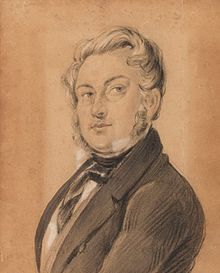Charles Rodius
Charles Rodius | |
|---|---|
 Self-portrait, c. 1849 | |
| Born | Joseph Meyer 1802 Cologne, Germany |
| Died | 9 April 1860 (aged 57–58) Sydney, New South Wales, Australia |
Charles Rodius (born Joseph Meyer, 1802 – 9 April 1860) was a German-born artist, printmaker and architect. Trained in France before moving to England, he was transported as a convict to the Australian penal colony of New South Wales for theft in 1829.
While not as well known as other convict artists, such as Joseph Lycett and Thomas Griffiths Wainewright, Rodius has received praise for his works, and he is represented in several major Australian galleries.
Early life and education
Rodius was born in 1802 in Cologne, Germany;[1] other sources give Hamburg as his place of birth as part of the large Jewish population of that city.[2][3] As a teenager he moved to Paris, France, where he studied art and worked as a teacher of "music, painting, drawing and languages in families of the first distinction".[4]
He move to London in 1927 where he changed his name to Charles Rodius.[2] There he was charged in early 1829 with stealing a perfume bottle, tickets, an opera glass and a handkerchief from a woman's purse. Rodius defended himself, arguing that the items were gifts from some of his female students. He was nonetheless convicted and sentenced to seven years' transportation to the Australian penal colony of New South Wales. At the time of his trial, he was described as "a young foreigner, dressed in a most fashionable style".[4]
Transportation to Australia

Rodius arrived in New South Wales aboard the convict ship Sarah in December 1829. Like Thomas Bock, Joseph Lycett, and other transported convicts with artistic abilities, Rodius's skills as a draughtsman were utilised by the colonial authorities and he was assigned to the Department of Public Works in Sydney.[4] He taught drawing to civil and military officers and helped to devise plans for proposed colonial buildings. Rodius was also commissioned as a portraitist by members of the colony's elite, such as Chief Justice Francis Forbes.[4] Having established himself as an artist with the reputation of a dandy, Rodius, with the support of his patronage, was granted a ticket of exemption in 1832—the year he began to earn his own living as an artist—which was changed to a ticket of leave two years later.[4]
Rodius remained in Australia where he continued to create portraits of well-known colonial identities, including explorer and fellow German
Rodius suffered a stroke in the late 1850s, leaving him paralysed on one side, and on 9 April 1860 he died "of infirmity" at Sydney's Liverpool Hospital.
His works were shown in a group exhibition at the National Portrait Gallery, Canberra, and the Tasmanian Museum and Art Gallery, Hobart, in 2012[5] The State Library of New South Wales held the first ever retrospective of his works in 2023–2024.[6]
See also
References
- ISSN 1833-7538.
- ^ The Weekend Australian. p. 12. Retrieved 24 October 2023.
- ISBN 978-1-925831-28-3. Retrieved 24 October 2023.
- ^ a b c d e f g h Gilmour, Joanna (1 June 2010). "Fine and dandy". Portrait. No. 36. Canberra: National Portrait Gallery. Retrieved 24 October 2023.
- ^ "Elegance in exile – Portrait drawings from colonial Australia". National Portrait Gallery (Australia). 2012. Retrieved 24 October 2023.
- ^ "Exhibition – Charles Rodius". State Library of New South Wales. Retrieved 24 October 2023.
External links
 Media related to Charles Rodius at Wikimedia Commons
Media related to Charles Rodius at Wikimedia Commons- Works at the State Library of New South Wales
- Works held at the National Portrait Gallery (Australia)
